
(CLICK IMAGES TO ENLARGE)
 In 1940 the average cost of a new car was $850.00. You could fill the gas tank for $1.54. The average price for a new house was $3,920.00. Greenwood residents wanting a night out could see a movie or a play at the Polk Community House. Or they could opt for a road trip and visit the Artcraft Theater in Franklin. Greenwood’s population had grown to 2,499. Changes large and small were on the horizon. The war in Europe was raging between Germany and the United Kingdom. Greenwood residents watched the newsreels at the local theaters and listened to the radio news, but it all seemed so far away. Events closer to home occupied their time.
In 1940 the average cost of a new car was $850.00. You could fill the gas tank for $1.54. The average price for a new house was $3,920.00. Greenwood residents wanting a night out could see a movie or a play at the Polk Community House. Or they could opt for a road trip and visit the Artcraft Theater in Franklin. Greenwood’s population had grown to 2,499. Changes large and small were on the horizon. The war in Europe was raging between Germany and the United Kingdom. Greenwood residents watched the newsreels at the local theaters and listened to the radio news, but it all seemed so far away. Events closer to home occupied their time.
Following the departure of Band Director Maurice Shadley in 1939, Greenwood High School had a vacancy to fill. They announced Shadley’s replacement on September 12 with the appointment of Miss Garnett Sackett. She was to take charge of band, chorus and orchestra. Miss Sackett was a graduate of the Indianapolis Conservatory of Music. She was a music instructor at Bainbridge Schools and had most recently taught at Mooresville from 1936 to 1939.
 Her acceptance of the position presented a bit of a logistics issue. Garnett lived in Greencastle with her father. The trek to Mooresville was long, but manageable. But, traveling twice a day from Greencastle to Greenwood in 1939 was a 3-hour ordeal. She soon relocated to Greenwood with her father.
Her acceptance of the position presented a bit of a logistics issue. Garnett lived in Greencastle with her father. The trek to Mooresville was long, but manageable. But, traveling twice a day from Greencastle to Greenwood in 1939 was a 3-hour ordeal. She soon relocated to Greenwood with her father.
Under the direction of Miss Sackett, Greenwood continued to compete in ISMA events. In April of 1940, the band won a Division I rating at the Plainfield contest as well as being awarded a first place trophy for “playing bands while marching.” The trophy was proudly displayed in the front window of the Carson Furniture Store in Greenwood. This was Greenwood’s third year in ISMA competition. They advanced to the state level competition in Danville on May 4 and won second place in Class C.
The band continued to perform at school and community events, including a PTA presentation in 1941. Greenwood also competed at ISMA Division and State competitions in 1941.
After only two years, Sackett and her father decided to relocate to South Carolina in the spring of 1941.
With the opening of Highway 31 providing a smooth, direct route from Indianapolis, the interurban system was used less and less. Following stiff competition from local bus lines, poorly maintained facilities and a series of deadly accidents, the interurban ceased operations in September 1941.
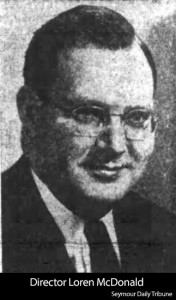 Over the summer of 1941, Greenwood High School searched for a replacement for Miss Sackett. They offered the job to Mr. Loren McDonald and he accepted. Mr. McDonald was a music instructor in Brownstown prior to accepting the Greenwood position. In addition to music, Mr. McDonald’s passions included flying and photography. He operated his own private plane and had a darkroom in his home to print his own photos.
Over the summer of 1941, Greenwood High School searched for a replacement for Miss Sackett. They offered the job to Mr. Loren McDonald and he accepted. Mr. McDonald was a music instructor in Brownstown prior to accepting the Greenwood position. In addition to music, Mr. McDonald’s passions included flying and photography. He operated his own private plane and had a darkroom in his home to print his own photos.
World events quickly overshadowed local events. The Japanese 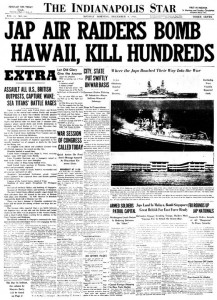 Imperial Navy attacked Pearl Harbor on the morning of December 7, 1941. This horrific attack led to the U.S. entrance into World War 2. The news left Greenwood residents huddling around their radios. Folks were shocked, then scared, then angry. Military enlistment soared and everyone worked with the new goal of entering the war and supplying the armed forces.
Imperial Navy attacked Pearl Harbor on the morning of December 7, 1941. This horrific attack led to the U.S. entrance into World War 2. The news left Greenwood residents huddling around their radios. Folks were shocked, then scared, then angry. Military enlistment soared and everyone worked with the new goal of entering the war and supplying the armed forces.
Shortly after this tragic national news, Greenwood suffered a tragedy of its own. Certainly nothing comparable to the national 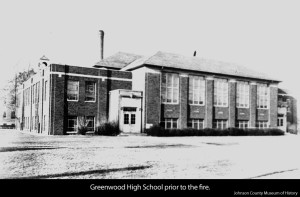 situation, but it was a terrible blow to the community. In the spring of 1942, the high school building, erected in 1927, was destroyed in a fire. Classes for high school students were held at various locations until they eventually were forced back into the original 12-room junior high school building. That arrangement would remain for the next eight years. In March of that year, the Greenwood band joined with Southport and Speedway schools and the chorus from Indiana Central
situation, but it was a terrible blow to the community. In the spring of 1942, the high school building, erected in 1927, was destroyed in a fire. Classes for high school students were held at various locations until they eventually were forced back into the original 12-room junior high school building. That arrangement would remain for the next eight years. In March of that year, the Greenwood band joined with Southport and Speedway schools and the chorus from Indiana Central  College for a benefit concert to be held at Southport High School. The purpose of the concert was to raise money for new instruments and uniforms for Greenwood to replace those lost in the fire. Community turnout and support was incredible! On May 21, the Greenwood band hosted an appreciation concert to acknowledge that community support. The concert was held outdoors on the lawn of the grade school. The concert featured rousing Sousa tunes, the overture from Snow White and closed with the singing of The Battle Hymn of the Republic.
College for a benefit concert to be held at Southport High School. The purpose of the concert was to raise money for new instruments and uniforms for Greenwood to replace those lost in the fire. Community turnout and support was incredible! On May 21, the Greenwood band hosted an appreciation concert to acknowledge that community support. The concert was held outdoors on the lawn of the grade school. The concert featured rousing Sousa tunes, the overture from Snow White and closed with the singing of The Battle Hymn of the Republic.
In October 1942 as part of the “Civilian War Co-operation” program, the Greenwood Lions Club 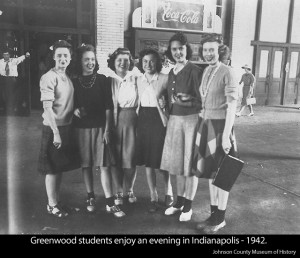 presented a program at the Polk Community House which included a short concert from the Greenwood band. Indianapolis radio station WIBC broadcast portions of the presentation.
presented a program at the Polk Community House which included a short concert from the Greenwood band. Indianapolis radio station WIBC broadcast portions of the presentation.
Loren McDonald left Greenwood in 1943 for a position in Defiance, Ohio. In June of that year, Greenwood announced that Mr. Paul O. Sawyer would be McDonald’s replacement. Mr. Sawyer had been band director at Decatur Central High School. The previous year, under Sawyer’s leadership, Decatur had held the third Annual Marion County Band Clinic. It was an invitational of a sort, but it was not a competition. Attending schools watched performances from bands including twirling, flag and percussion.
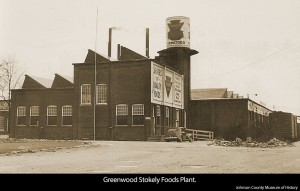 The war effort occupied everyone’s thoughts. Even those who did not have family in the fighting did their part on the home front. The Polk Canning Company had been purchased by Stokely Foods in 1930. Stokely, like numerous companies during this time, produced needed products for the troops. On March 27, 1944, the Greenwood Stokely plant was recognized with the Achievement “A” Award by the War Food Administration. In addition to speeches and presentations, the program included a performance by the Greenwood band under the direction of
The war effort occupied everyone’s thoughts. Even those who did not have family in the fighting did their part on the home front. The Polk Canning Company had been purchased by Stokely Foods in 1930. Stokely, like numerous companies during this time, produced needed products for the troops. On March 27, 1944, the Greenwood Stokely plant was recognized with the Achievement “A” Award by the War Food Administration. In addition to speeches and presentations, the program included a performance by the Greenwood band under the direction of 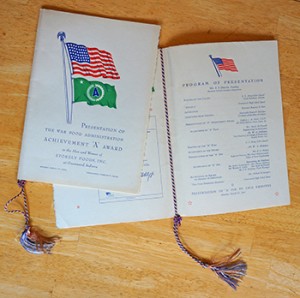 Paul Sawyer. Download a PDF of the program by clicking on the picture. The program is a gift of William Alexander (Alex) Hibbard. Alex’s great-grandfather, William Aubrey Hughey, was a soldier in WW II and his great-great-grandfather, Henry Alexander Hughey, was an employee at the Greenwood Stokely plant. Alex’s family preserved two of the programs since 1944. He donated them to Greenwood schools in 2013.
Paul Sawyer. Download a PDF of the program by clicking on the picture. The program is a gift of William Alexander (Alex) Hibbard. Alex’s great-grandfather, William Aubrey Hughey, was a soldier in WW II and his great-great-grandfather, Henry Alexander Hughey, was an employee at the Greenwood Stokely plant. Alex’s family preserved two of the programs since 1944. He donated them to Greenwood schools in 2013.
Director Sawyer shared one of the most significant events of the 20th century with his band students. On May 8, 1945, Germany surrendered—ending the war in Europe. The Greenwood band literally took to the streets. Traffic was stopped in downtown and the band performed in the intersection of Madison and Main to an ecstatic crowd. Folks sang along with the band as they played patriotic 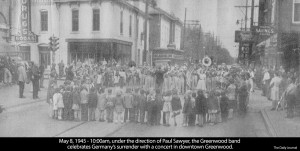 songs. Then President Truman made the official announcement of Germany’s surrender over the radio, lending an official air to the big news. Click here to listen to Truman’s speech. Energized, Mr. Sawyer directed the band in a well-received repeat performance. This was Paul Sawyer’s last performance with Greenwood. Like his two predecessors, he remained with Greenwood for only two years. He was offered a position in the Tipton school system to begin in the fall.
songs. Then President Truman made the official announcement of Germany’s surrender over the radio, lending an official air to the big news. Click here to listen to Truman’s speech. Energized, Mr. Sawyer directed the band in a well-received repeat performance. This was Paul Sawyer’s last performance with Greenwood. Like his two predecessors, he remained with Greenwood for only two years. He was offered a position in the Tipton school system to begin in the fall.
Following atomic bomb detonations over Hiroshima and Nagasaki, Japan surrendered on August 15 and the surrender was officially signed on September 2.  World War II was over! Everyone was excited, relieved, exhausted and thoughtful. The war had been costly—in both lives and resources. It would take years to deal with all the changes the war had brought to the world and to local communities. But, everyone adapted. Greenwood residents were anxious to get back to simpler lives and smaller concerns, like, “who will be directing my band kids?”
World War II was over! Everyone was excited, relieved, exhausted and thoughtful. The war had been costly—in both lives and resources. It would take years to deal with all the changes the war had brought to the world and to local communities. But, everyone adapted. Greenwood residents were anxious to get back to simpler lives and smaller concerns, like, “who will be directing my band kids?”
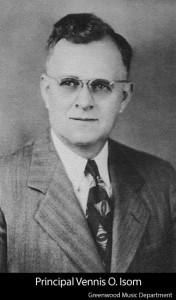
 The new school year would begin on September 10, and Greenwood, again, needed a new director. Greenwood Principal Vennis O. Isom (who would later later be honored with an elementary school in his name) offered the position to Robert Egloff and he accepted the assignment of band director and math teacher. Greenwood continued competing on the ISMA circuit. At the end of the school year, the Greenwood brass ensemble performed at an Indiana Central College program. That May, Greenwood’s class of 1946 had 27 members.
The new school year would begin on September 10, and Greenwood, again, needed a new director. Greenwood Principal Vennis O. Isom (who would later later be honored with an elementary school in his name) offered the position to Robert Egloff and he accepted the assignment of band director and math teacher. Greenwood continued competing on the ISMA circuit. At the end of the school year, the Greenwood brass ensemble performed at an Indiana Central College program. That May, Greenwood’s class of 1946 had 27 members.
Following the precedent set by the three previous band directors, Bob Egloff remained with Greenwood for two years before moving on. His successor, however, would finally break the two-year tradition.
Add your voice to the story. Add a comment below. All comments are moderated before posting.
All contents are © Greenwood Community High School. All rights reserved. Attribution of photographs has been given when known.


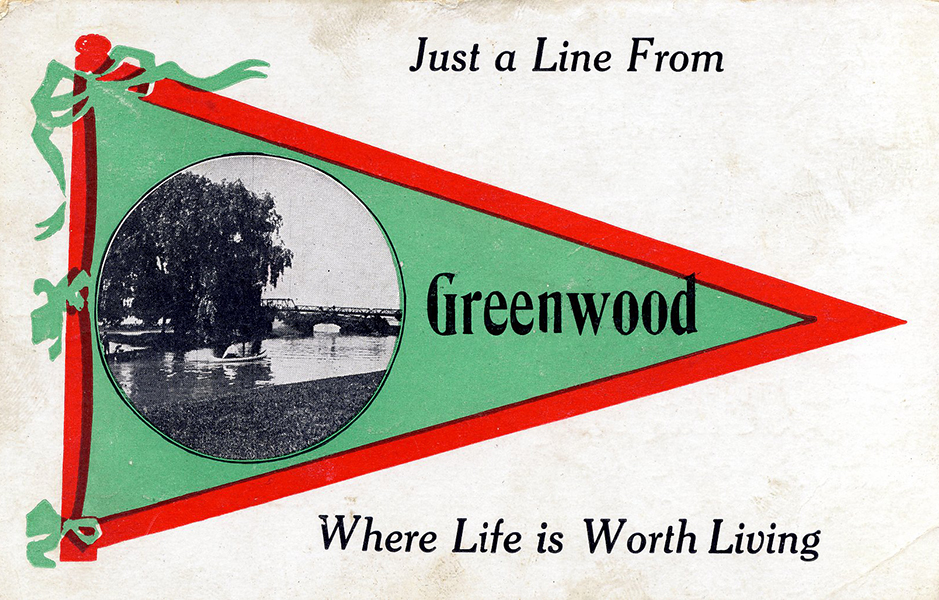
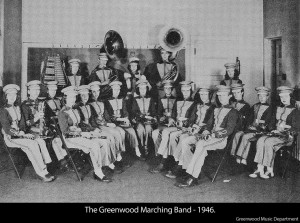
Leave A Comment